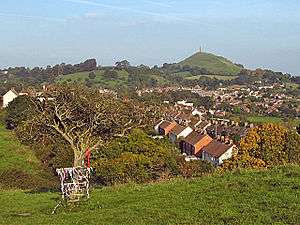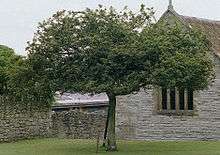Glastonbury Thorn

The Glastonbury thorn is a form of common hawthorn, Crataegus monogyna 'Biflora'[1] (sometimes incorrectly called Crataegus oxyacantha var. praecox), found in and around Glastonbury, Somerset, England. Unlike ordinary hawthorn trees, it flowers twice a year (hence the name "biflora"), the first time in winter and the second time in spring. The trees in the Glastonbury area have been propagated by grafting since ancient times.[1] The tree is also widely called the holy thorn, though this term strictly speaking refers to the original (legendary) tree.[2][3]
It is associated with legends about Joseph of Arimathea and the arrival of Christianity in Britain, and has appeared in written texts since the medieval period. A flowering sprig is sent to the British Monarch every Christmas. The original tree has been propagated several times, with one tree growing at Glastonbury Abbey and another in the churchyard of the Church of St John. The "original" Glastonbury thorn was cut down and burned as a relic of superstition during the English Civil War, and one planted on Wearyall Hill in 1951 to replace it had its branches cut off in 2010.
History
According to legend, Joseph of Arimathea visited Glastonbury with the Holy Grail and thrust his staff into Wearyall Hill, which then grew into the original thorn tree.[4][5][6] Early writers do not connect Joseph to the arrival of Christianity in Britain, and the first literary source to place him in Britain appeared in the ninth century.[7] The historicity of Joseph's presence in Glastonbury remains controversial, but the thorn is first mentioned in an early sixteenth-century metrical Lyfe of Joseph of Arimathea. The anonymous author notes that the thorn was unusual in that it flowered twice in a year, once as normal on "old wood" in spring, and once on "new wood" (the current season's matured new growth) in the winter. This flowering of the Glastonbury thorn in mild weather just past midwinter was accounted miraculous.[8]
At the time of the adoption of the revised Gregorian calendar in Britain in 1752, the Gentleman's Magazine reported that curious visitors went to see whether the Glastonbury thorn kept to the Julian calendar or the new one:
Glastonbury.—A vast concourse of people attended the noted thorn on Christmas-day, new style; but, to their great disappointment, there was no appearance of its blowing, which made them watch it narrowly the 5th of January, the Christmas-day, old style, when it blowed as usual.
- Gentleman's Magazine January 1753
The original Glastonbury thorn itself was cut down and burned as a relic of superstition by Cromwellian troops (or 'Roundheads' by another source) during the English Civil War (1642–1651).[4][9]
Royal tradition
The custom of sending a budded branch of the Glastonbury thorn to the Queen at Christmas was initiated by James Montague, Bishop of Bath and Wells during James I's reign, who sent a branch to Queen Anne, King James I's consort. A spray of thorn was sent to the Sovereign each Christmas by the Vicar and Mayor of Glastonbury.[10] The thorn also featured on British Postage stamps on the 12p and 13p Christmas stamps in 1986.[11][12]
2010 Deliberate damage
The Glastonbury thorn was once again attacked and its branches cut off, in this case the 1951 specimen that was growing on Wearyall Hill on the southwestern side of the town, on 9 December 2010.[4][5][6][13] In March 2011, it was reported that a new shoot had appeared on the damaged tree.[14] However, as these new shoots came up they would suspiciously disappear a few days or weeks later.[15]
2012 replanting and further damage
On 1 April 2012 a sapling grafted from a descendant of the pre-1951 specimen was planted by the landowners working with Glastonbury Conservation Society and consecrated, but it was snapped in half and irreparably damaged 16 days later.[15]
Propagation

Many have tried to grow the Glastonbury thorn from seed and direct cuttings, but in the later part of the 20th century all attempts reverted to the normal hawthorn type, flowering only in spring.[16]
This tree has been widely propagated by grafting or cuttings, with the cultivar name 'Biflora' or 'Praecox'. An early antiquarian account by Mr Eyston was given in Hearse's History and Antiquities of Glastonbury, 1722 : "There is a person about Glastonbury who has a nursery of them, who, Mr. Paschal tells us he is informed, sells them for a crown a piece, or as he can get."[17]
The tree in the grounds of the church was pronounced dead in June 1991, and cut down the following February.[18] However, many cuttings were taken from it before its destruction. The pre-1991 thorn in the grounds of Glastonbury Church is said to be a cutting from the original plant which was planted in secret after the original was destroyed. Now only trees budded or grafted from the original exist, and these blossom twice a year, in May and at Christmas. The blossoms of the Christmas shoots are usually much smaller than the May ones and do not produce any haws. Plants grown from the haws do not retain the characteristics of the parent stem.
The present "sacred thorn tree" at the Church of St John was grown from a local cutting, like many others in the neighbourhood of Glastonbury. The large tree had been in the churchyard for eighty years. It was planted by Mr George Chislett, then head gardener of Glastonbury Abbey. He also learned how to graft holy thorn cuttings onto the root of blackthorn stock, and so preserve the “miraculous” Christmas blossoming characteristic. His son, Wilf, sent Glastonbury thorn cuttings all over the world, including to Washington, Canada, New Zealand and Australia.
Luckily, trees survive from earlier grafts to perpetuate the Glastonbury legend, among them two other holy thorns in the grounds of St John’s. The blossom sent to the Queen now comes from one of these. At the end of term, the pupils of St John’s Infants School gather round the tree in St John’s parish churchyard on the High Street. They sing carols, including one specially written for the occasion, and the oldest pupil has the privilege of cutting the branch of the Glastonbury thorn that is then taken to London and presented to Her Majesty The Queen. In 1965, the Queen erected a wooden cross at Glastonbury with the following inscription: "The cross, the symbol of our faith, the gift of Queen Elizabeth II, marks a Christian sanctuary so ancient that only legend can record its origin."
References
- 1 2 Phipps, J.B.; O’Kennon, R.J.; Lance, R.W. 2003. Hawthorns and medlars. Royal Horticultural Society, Cambridge, U.K.
- ↑ "The mystery over who attacked the Holy Thorn Tree)". BBC. Retrieved 2016-01-13.
- ↑ "The Holy Thorn". Glastonbury Abbey. Retrieved 2016-01-13.
- 1 2 3 Salkeld, Luke (9 December 2010). "Vandals have hacked at the heart of Christianity: 2000-year-old Holy Thorn Tree of Glastonbury is cut down". Daily Mail Online (London). Retrieved 9 December 2010.
- 1 2 "Historic Holy Thorn tree cut down in Glastonbury". BBC News. 9 December 2010. Retrieved 10 December 2010.
- 1 2 Hallett, Emma (9 December 2010). "Vandals destroy sacred thorn tree". London: The Independent. Retrieved 10 December 2010.
- ↑ Bodleian Library. "Manuscripts". "MS. Laud 108 of the Bodleian". University of Pennsylvania Medieval archive.
- ↑ "Part 5. Glastonbury Thorn". Albion Revisteted. Retrieved 17 April 2011.
- ↑ Walters, Cuming (1897). Bygone Somerset. London: William Andrews. pp. 48–52.
- ↑ "Sprig of Holy Thorn in Glastonbury is cut for the Queen". BBC. 8 December 2010. Retrieved 10 December 2010.
- ↑ "British stamps for 1986". Collect GB Stamps. Retrieved 10 December 2010.
- ↑ Rahtz, Philip; Lorna Watts (2003). Glastonbury Myth & Archeology. Stroud: Tempus Publishing. pp. 59–61. ISBN 978-0-7524-2548-1.
- ↑ Kennedy, Maev (9 December 2010). "Glastonbury Thorn chopped down as town rages over attack on famous tree". London: The Guardian. Retrieved 10 December 2010.
- ↑ "Vandalised Holy Thorn in Glastonbury has a new shoot". BBC News. 28 March 2011. Retrieved 29 March 2011.
- 1 2 "Glastonbury Thorn: News". Glastonbury Pilgrim Reception Centre. Retrieved 29 November 2012.
- ↑ Searle, Muriel V. (2002). West Country History: Somerset. Bristol: Venton Publications. p. 16. ISBN 1-84150-802-0.
- ↑ Robert, Robert (1869). "Legend of the Glastonbury Thorn". The Book of Days. Retrieved 2008-08-19.
- ↑ Bowman, Marion (August 2006). "The Holy Thorn Ceremony: Revival, Rivalry and Civil Religion in Glastonbury". Folklore 117: 117 123–140. doi:10.1080/00155870600707805. Retrieved 2008-08-19.
External links
- BBC article
 Media related to Holy Thorn, Glastonbury at Wikimedia Commons
Media related to Holy Thorn, Glastonbury at Wikimedia Commons